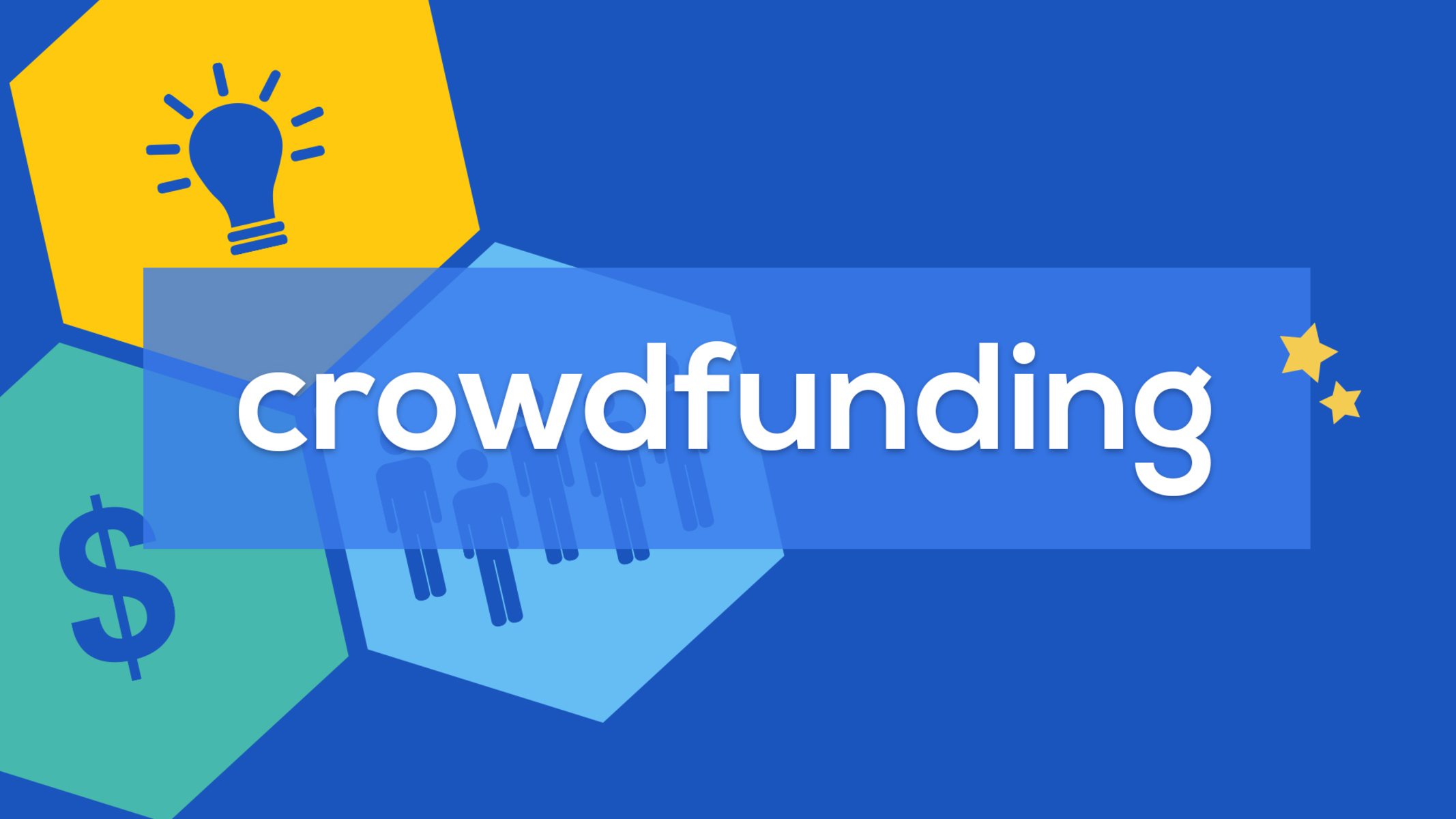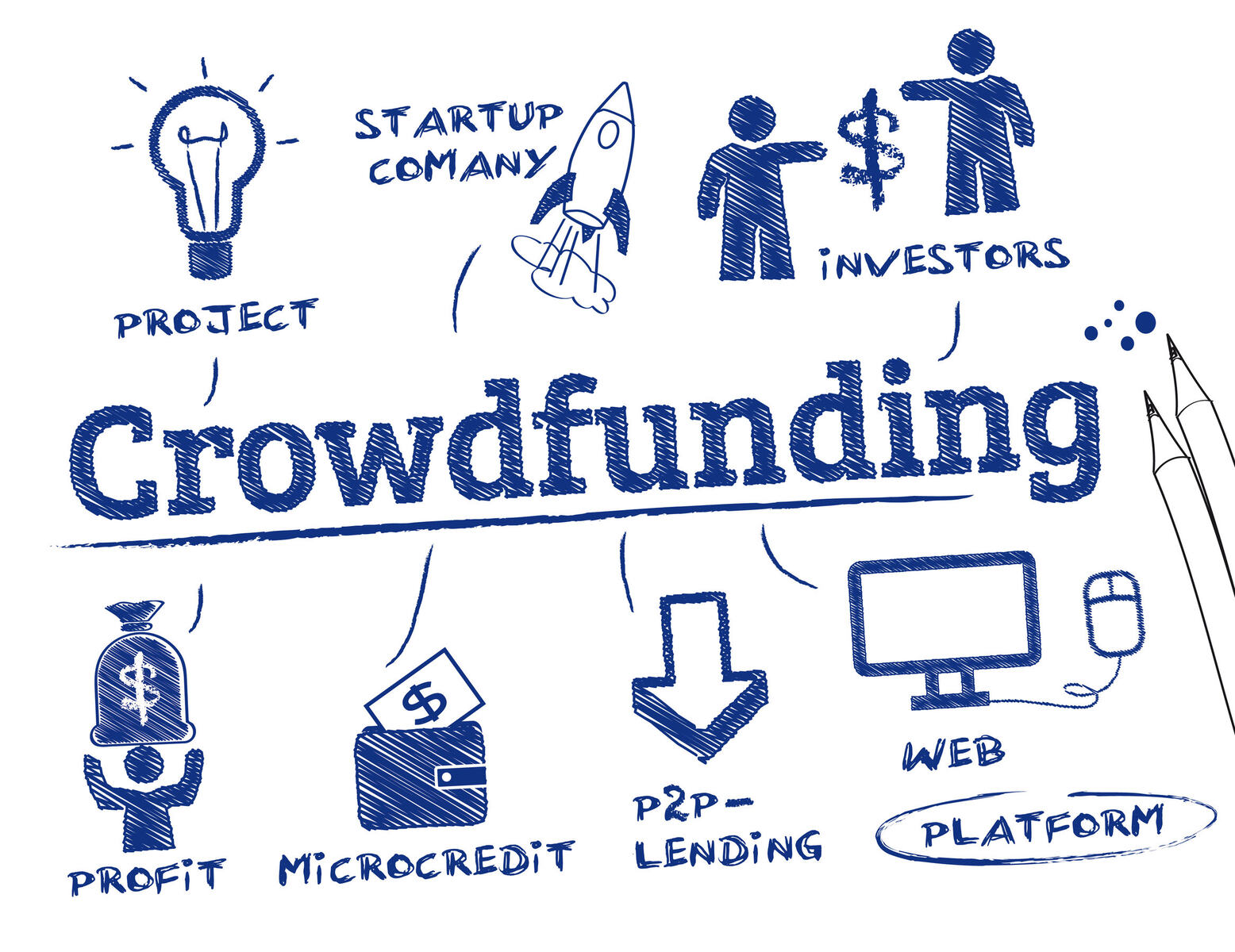Introduction
Crowdfunding has emerged as a popular and innovative way to raise funds for projects, ideas, and businesses. In recent years, it has become a powerful tool that empowers individuals and organizations to turn their dreams into reality. Through the collective support of a large number of people, crowdfunding has revolutionized the traditional fundraising landscape.
Crowdfunding, as the name suggests, involves funding a project or venture through a crowd of people who contribute small amounts of money. Instead of relying on a single large investor or financial institution, crowdfunding allows entrepreneurs, artists, nonprofits, and individuals from all walks of life to access capital from a diverse pool of supporters.
The growth of crowdfunding can be attributed to the rise of technology and the internet. Online platforms have made it easier than ever to connect with potential backers and share compelling stories. Additionally, the widespread use of social media has enabled campaigns to reach a broader audience, maximizing the chances of success.
Not only has crowdfunding reshaped the fundraising landscape, but it has also brought about significant social and economic changes. It has empowered individuals and communities to become active participants in shaping the projects and initiatives they care about. The democratizing nature of crowdfunding allows anyone with a great idea to gain support and bring it to life, regardless of their background or financial resources.
In this article, we will delve into the world of crowdfunding, exploring its various types, the benefits it offers, and the challenges it presents. Whether you are an entrepreneur looking to fund your startup, a supporter eager to contribute to meaningful causes, or simply curious about this groundbreaking financial solution, read on to discover the power and potential of crowdfunding.
Definition of Crowdfunding
Crowdfunding refers to the practice of raising small amounts of money from a large number of individuals to fund a specific project or venture. It is a form of alternative financing that allows entrepreneurs, artists, inventors, and nonprofits to bypass traditional financial institutions and connect directly with potential backers.
At its core, crowdfunding is about harnessing the power of the crowd to support and invest in ideas, causes, or businesses that resonate with them. The concept is rooted in the belief that a collective of many individuals contributing small amounts can have a greater impact than a single large investor.
Unlike traditional funding methods, such as bank loans or venture capital, crowdfunding is more accessible to a wider range of individuals. It provides an opportunity for aspiring entrepreneurs with limited resources to turn their visions into reality. Similarly, it allows individuals to support projects or causes that align with their interests or values.
In a crowdfunding campaign, the person or organization seeking funds creates a compelling pitch or proposal and sets a funding goal. They then share their campaign on a crowdfunding platform or website, where potential backers can learn about the project and make monetary contributions.
There are various types of crowdfunding, each with its own set of rules and mechanisms for raising funds. These include rewards-based crowdfunding, equity-based crowdfunding, donation-based crowdfunding, peer-to-peer lending, and real estate crowdfunding. Each type offers unique benefits and considerations for both project creators and backers.
In the next sections, we will dive into each type of crowdfunding and explore their respective characteristics and use cases. By understanding the different ways in which crowdfunding can be utilized, you can determine which approach best aligns with your goals and aspirations.
History of Crowdfunding
Crowdfunding may seem like a recent phenomenon, but its roots can be traced back several centuries. The concept of pooling resources to support a common cause or project has been practiced in various forms throughout history.
One of the earliest instances of crowdfunding can be seen in the construction of public monuments and buildings. In ancient civilizations, individuals and communities would collectively contribute funds to finance the creation of structures that would benefit the entire population.
In more recent history, crowdfunding took the form of subscription-based models in the 17th and 18th centuries. Projects such as the publication of books or the establishment of new ventures would solicit subscriptions from interested individuals. These subscribers would provide advance payment to support the development of the project.
Over time, crowdfunding evolved further with the emergence of mutual associations and cooperative movements. These organizations allowed individuals to pool their resources and provide financial assistance to those in need, such as farmers or entrepreneurs.
The digital age marked a significant turning point for crowdfunding. In the early 2000s, online platforms began to emerge, providing a new way for creators to connect with potential backers. These platforms leveraged the power of the internet and social media to reach wider audiences and facilitate seamless transactions.
One of the landmark events in the history of crowdfunding was the launch of Kickstarter in 2009. Kickstarter popularized the rewards-based crowdfunding model, allowing creators to offer incentives to backers based on their contribution. This model gained immense popularity and opened doors for many innovative projects to secure funding.
Equity-based crowdfunding gained traction with the passage of the Jumpstart Our Business Startups (JOBS) Act in the United States in 2012. This legislation relaxed regulations and allowed startups to offer equity in exchange for investment through online platforms.
Since then, crowdfunding has witnessed exponential growth and global adoption. It has become a go-to funding option for entrepreneurs, artists, creative individuals, and nonprofit organizations seeking support and validation for their ideas and initiatives.
Today, crowdfunding continues to evolve, with new platforms and models constantly emerging. It has transformed the way funds are raised and democratized access to capital, empowering individuals and communities worldwide to bring their dreams to life.
Types of Crowdfunding
Crowdfunding encompasses various models and approaches, each tailored to cater to specific funding needs and objectives. Understanding the different types of crowdfunding can help both project creators and backers determine the most suitable avenue to achieve their goals. Let’s explore some of the most common types of crowdfunding:
- Rewards-Based Crowdfunding: This is the most popular type of crowdfunding where creators offer rewards or incentives to backers who contribute to their campaign. These rewards can be tangible items, early access to products, or exclusive experiences. Backers are motivated by the desire to receive these rewards rather than seeking financial returns.
- Equity-Based Crowdfunding: In equity-based crowdfunding, backers make investments in exchange for equity or shares in the venture. This model is typically used by startups and early-stage companies seeking capital to grow. Backers become shareholders and have the potential to earn financial returns if the venture succeeds.
- Donation-Based Crowdfunding: Donation-based crowdfunding involves individuals contributing funds without expecting any financial returns or rewards. This model is often used for charitable causes, medical emergencies, disaster relief, or community projects. It relies on the generosity and empathy of individuals who want to make a positive impact.
- Peer-to-Peer Lending: Peer-to-peer lending, also known as debt-based crowdfunding, involves individuals lending money to others in need. The borrower agrees to repay the loan with interest over a specified period. This model cuts out the intermediaries like banks and allows individuals to support each other financially.
- Real Estate Crowdfunding: Real estate crowdfunding enables individuals to invest in real estate properties or development projects. Investors contribute funds, and in return, they receive a share of the rental income or profits generated from the property. This opens up opportunities for individuals to diversify their investment portfolio and participate in the lucrative real estate market.
Each type of crowdfunding has its own advantages, considerations, and legal implications. It is important for both project creators and backers to carefully evaluate the specific requirements and risks associated with each model. Choosing the right type of crowdfunding is crucial for ensuring a successful campaign and meeting the desired objectives.
Rewards-Based Crowdfunding
Rewards-based crowdfunding is one of the most popular and widely used types of crowdfunding. It allows project creators to offer various incentives or rewards to individuals who contribute to their campaign. This model appeals to backers who are motivated not by financial returns, but by the desire to receive a unique and meaningful reward in return for their support.
In a rewards-based crowdfunding campaign, creators set up different reward tiers based on the amount of money backers contribute. These rewards can range from small tokens of appreciation, such as personalized thank-you notes or digital badges, to more substantial rewards like early access to the product or exclusive merchandise.
One of the key advantages of rewards-based crowdfunding is that it allows project creators to validate their idea and gauge market interest. By offering different rewards, creators can gain insights into which aspects of their project resonate most with potential customers or supporters. This valuable feedback can help them refine their offerings, marketing strategy, and overall business plan.
For backers, rewards-based crowdfunding offers the opportunity to be part of the development process and receive unique benefits unavailable elsewhere. They get satisfaction from contributing to a project they believe in and receiving tangible or intangible rewards that symbolize their involvement and support.
Platforms such as Kickstarter and Indiegogo have gained significant popularity as intermediaries for hosting rewards-based crowdfunding campaigns. These platforms provide project creators with a ready-made audience and a user-friendly interface for managing campaigns, tracking contributions, and delivering rewards.
However, running a successful rewards-based crowdfunding campaign requires strategic planning and execution. Creators must craft compelling and engaging campaign pages that effectively communicate their vision, value proposition, and the impact their project will make. They need to establish trust and credibility with potential backers, showcasing their expertise, previous work, and a well-thought-out plan for executing the project.
Additionally, creators need to fulfill their promises and deliver rewards in a timely manner once the campaign concludes. This is crucial for maintaining a good reputation and building trust with backers. Communication and transparency throughout the campaign are key to ensuring a positive backer experience and fostering a sense of community.
Overall, rewards-based crowdfunding presents an exciting opportunity for creators and backers alike. It enables creators to fund their projects, gain valuable feedback, and build a dedicated community around their ideas. Backers, on the other hand, can be part of the creative process, receive exclusive rewards, and support projects that align with their interests.
Equity-Based Crowdfunding
Equity-based crowdfunding is a type of crowdfunding where individuals invest money in a business or venture in exchange for ownership or equity shares. Unlike rewards-based crowdfunding, backers who participate in equity-based campaigns have the potential to earn financial returns if the venture succeeds.
This model gained significant popularity with the passage of the Jumpstart Our Business Startups (JOBS) Act in the United States in 2012. The JOBS Act relaxed regulations and allowed startups and small businesses to offer equity to non-accredited investors through online platforms.
Equity-based crowdfunding provides opportunities for individuals to invest in early-stage companies that show promise for growth. By owning equity shares, backers become stakeholders in the venture and can benefit from any potential profits or value appreciation over time. They may also have the right to participate in decision-making processes, depending on the terms of the investment.
This type of crowdfunding benefits both entrepreneurs and investors. For entrepreneurs, equity-based crowdfunding offers an alternative financing option to secure capital for their business. It allows them to access a larger pool of potential investors and diversify their funding sources beyond traditional venture capital or angel investors.
On the other hand, investors who participate in equity-based crowdfunding have the opportunity to support innovative startups and potentially earn substantial returns on their investments if the venture succeeds. They can also contribute their expertise, networks, and experience to help the business grow.
However, it’s important to note that equity-based crowdfunding involves certain risks. Investing in early-stage companies carries a higher level of uncertainty, as there is a greater chance of failure compared to established businesses. Investors need to carefully evaluate the potential risks and do their due diligence before making investment decisions.
Equity-based crowdfunding campaigns typically involve detailed business plans, financial projections, and legal documentation, which provide potential investors with the necessary information to assess the investment opportunity. Platforms that facilitate equity-based crowdfunding often have screening processes in place to ensure compliance with regulations and protect the interests of both entrepreneurs and investors.
Equity-based crowdfunding has opened up new avenues for entrepreneurs to raise capital while democratizing access to investment opportunities for a wider range of individuals. It allows startups with innovative ideas to tap into a larger pool of investors who are passionate about supporting early-stage ventures and potentially sharing in their success.
However, prospective investors should be mindful of the risks associated with equity-based crowdfunding and seek professional advice when necessary. By weighing the potential rewards against the risks, individuals can make informed investment decisions and participate in the exciting world of equity-based crowdfunding.
Donation-Based Crowdfunding
Donation-based crowdfunding is a type of crowdfunding that involves individuals making monetary contributions to support a cause, project, or individual without expecting any financial returns or rewards. It is driven by philanthropy and the desire to make a positive impact in the world.
This type of crowdfunding is often used for charitable causes, nonprofit organizations, medical emergencies, disaster relief efforts, community projects, and personal endeavors. It harnesses the collective power of many small donations to achieve a common goal or address a pressing need.
Donation-based crowdfunding platforms provide a space for individuals or organizations to share their initiatives, explain their mission, and solicit financial support from compassionate individuals who resonate with their cause. These platforms help connect passionate individuals with projects that align with their values, creating a sense of community and shared purpose.
One of the key advantages of donation-based crowdfunding is that it allows even small contributions to make a significant impact when combined with others. It empowers individuals who may not have substantial financial resources to still contribute to causes they care about. Additionally, donors derive a sense of fulfillment and satisfaction from knowing that their contributions are making a positive difference in the lives of others.
Transparency and accountability are important aspects of donation-based crowdfunding. Project creators have a responsibility to clearly communicate how the funds will be used and provide regular updates to donors on the progress and impact of their initiatives. This transparency not only builds trust but also encourages continued support and engagement from the donor community.
Donation-based crowdfunding campaigns often leverage the power of storytelling to emotionally connect with potential donors. By sharing personal narratives, photographs, and videos, project creators can evoke empathy, generate awareness, and inspire individuals to contribute. This personal connection helps potential donors understand the significance of their support and encourages them to spread the word to their networks.
While donation-based crowdfunding does not offer financial returns, it provides an opportunity for individuals to be part of a larger movement and contribute to causes that align with their values. It allows people to support projects and initiatives that may not receive traditional funding or attention.
Whether it’s helping someone in need, supporting environmental conservation efforts, or funding educational programs, donation-based crowdfunding enables regular people to collectively make a positive impact on society. It embodies the spirit of giving and the belief that together we can create lasting change.
Peer-to-Peer Lending
Peer-to-peer lending, also known as P2P lending, is a type of crowdfunding where individuals borrow money directly from other individuals or investors, cutting out traditional financial institutions such as banks. This lending model creates a win-win situation, allowing borrowers to access funds at competitive interest rates, and lenders to earn interest on their investments.
In peer-to-peer lending, borrowers create profiles and provide information about their creditworthiness, financial history, and the purpose of the loan. Lenders can then review these profiles and choose to fund the borrowers they find most suitable. The loan is typically facilitated by a P2P lending platform that acts as an intermediary, handling the transaction and providing a secure platform for communication and documentation.
One of the primary advantages of peer-to-peer lending is that it offers borrowers an alternative source of financing when traditional loans may be difficult to obtain. It provides flexibility and convenience, allowing individuals with lower credit scores or non-traditional income sources to access funds for various purposes such as debt consolidation, home improvement, or small business financing.
For lenders, peer-to-peer lending presents an opportunity to diversify their investment portfolio and earn attractive returns. By spreading their investments across different borrowers, lenders can mitigate risks and potentially earn higher interest rates compared to traditional savings accounts or other investment options.
The peer-to-peer lending model operates on the principle of shared responsibility and trust. Lenders assess the borrowers’ creditworthiness, repayment history, and other factors to determine the risk associated with the loan. As with any investment, due diligence is crucial to minimize the potential for defaults or late repayments.
P2P lending platforms often provide tools and resources to help lenders make informed decisions and assess the creditworthiness of borrowers. These platforms facilitate loan servicing, including repayment tracking, collections, and providing legal recourse in case of default.
Peer-to-peer lending has gained popularity due to its efficiency, transparency, and lower overhead costs compared to traditional lending institutions. It gives individuals more control over their financial decisions and fosters a sense of community and collaboration.
However, it’s important for both borrowers and lenders to carefully evaluate the terms and conditions of peer-to-peer lending, including interest rates, fees, and repayment terms. Borrowers should ensure they have a solid repayment plan in place, while lenders should assess the risk and potential returns associated with each investment.
Overall, peer-to-peer lending has revolutionized the lending landscape by creating a more inclusive and accessible system for borrowing and lending money. It provides opportunities for individuals to support each other financially and build mutually beneficial relationships outside of traditional financial institutions.
Real Estate Crowdfunding
Real estate crowdfunding is a type of crowdfunding that allows individuals to invest in real estate properties or development projects. This form of crowdfunding opens up opportunities for investors to participate in the real estate market and diversify their investment portfolios.
Traditionally, investing in real estate required significant capital and expertise. However, real estate crowdfunding has democratized access to this asset class, allowing individuals with various budget levels to invest in properties that align with their investment goals.
Through real estate crowdfunding platforms, investors can browse and select from a wide range of investment opportunities. These opportunities may include residential properties, commercial buildings, apartment complexes, or even real estate development projects.
Investors can contribute funds toward a specific project and, in return, receive a share of the rental income or profits generated by the property. This allows individuals to access potential returns on real estate investments without the need to manage properties or handle the associated responsibilities.
Real estate crowdfunding platforms provide investors with detailed information about each investment opportunity, including financial projections, property details, and associated risks and returns. This transparency allows investors to make informed decisions based on their risk tolerance and investment preferences.
Benefits of real estate crowdfunding include diversification, as investors can spread their investment across multiple properties or projects, and access to markets that may otherwise be inaccessible. Additionally, real estate crowdfunding platforms handle the legal and administrative aspects of the investment, making it a hassle-free option for investors.
For property owners or developers, real estate crowdfunding offers an alternative financing model to fund their projects. It enables them to raise capital from a larger pool of investors by offering equity or debt ownership in the property or project. This can be particularly beneficial for small developers or individuals looking to break into the real estate market.
However, it is important for both investors and property owners to conduct thorough due diligence before participating in real estate crowdfunding. Assessing the reputation and track record of the platform, evaluating property details and financial projections, and understanding the associated risks are crucial steps in making informed investment decisions.
Real estate crowdfunding has transformed the way people invest in and finance real estate projects. It provides opportunities for smaller investors to participate in the lucrative real estate market while enabling property owners and developers to access a larger pool of capital.
Whether it’s investing in income-generating properties or supporting innovative real estate development projects, real estate crowdfunding offers a flexible, transparent, and accessible avenue for individuals to take part in the world of real estate investing.
Why Crowdfunding?
Crowdfunding has gained immense popularity in recent years, revolutionizing the way projects are funded and transforming the traditional fundraising landscape. Whether you are an entrepreneur, a supporter, or an investor, there are compelling reasons why crowdfunding has become a go-to solution. Let’s explore some of the key benefits and motivations behind the widespread adoption of crowdfunding:
- Funding Projects and Startups: Crowdfunding provides a platform for entrepreneurs and innovators to access capital and turn their ideas into reality. It allows creators to reach a wide audience of potential backers who can provide financial support, helping them overcome the barriers associated with traditional funding methods.
- Supporting Charitable Causes and Nonprofits: Crowdfunding has become a powerful tool for individuals and organizations to raise funds for charitable causes. It enables individuals to support initiatives that align with their values and make a positive impact in areas such as education, healthcare, social justice, and environmental conservation.
- Investing in Promising Ventures: Equity-based crowdfunding provides an opportunity for investors to participate in the growth of startups and early-stage companies. It allows individuals to invest in ventures they believe in and potentially reap financial returns if the venture succeeds.
- Engaging with a Community: Crowdfunding fosters a sense of community and engagement. Backers become part of a project’s journey and can provide feedback, ideas, and support. The crowdfunding process often involves storytelling and personal connections, creating a sense of shared purpose and connection.
- Benefits for Entrepreneurs and Small Businesses: Crowdfunding offers numerous advantages for entrepreneurs and small businesses. It allows them to validate their ideas, assess market interest, and gauge the demand for their products or services. Additionally, crowdfunding can be a powerful marketing tool, helping businesses build a loyal customer base and generate awareness about their brand.
Moreover, crowdfunding has reduced barriers and empowered individuals from diverse backgrounds to pursue their passions and dreams. It enables projects and causes that may have faced difficulty in securing funding through traditional channels to gain support from a global network of backers.
While crowdfunding presents numerous opportunities, it also comes with challenges. Legal considerations, selecting the right platform, and running successful campaigns require careful planning, execution, and continuous engagement with the backer community. However, for those who are willing to invest the time and effort, crowdfunding can be a game-changer in transforming ideas into reality.
Funding Projects and Startups
Crowdfunding has emerged as a powerful tool for entrepreneurs and innovators seeking funds to turn their ideas into reality. It provides a platform that connects project creators with individuals who are willing to contribute financially to support their ventures. Here are some key reasons why crowdfunding has become a popular choice for funding projects and startups:
Access to Capital: Crowdfunding opens up avenues for entrepreneurs who may struggle to secure funding through traditional channels. Instead of relying on a single investor or financial institution, crowdfunding allows creators to tap into the collective support of a large number of individuals. This widens the pool of potential funders and increases the chances of obtaining the necessary capital.
Validation and Market Interest: When launching a new project or startup, it is essential to validate the idea and assess market interest. Crowdfunding provides an opportunity for creators to showcase their ideas and gauge the demand for their products or services. The level of support and engagement received from backers can serve as an indicator of market potential and help creators refine their offerings based on real-time feedback.
Marketing and Brand Awareness: Crowdfunding campaigns act as a marketing tool that allows entrepreneurs to generate buzz and build awareness around their projects or startups. By promoting their campaigns on social media, traditional media, and crowdfunding platforms, creators can reach a wide audience beyond their immediate network. As a result, crowdfunding serves as a platform for exposure and can attract potential customers or investors who may be interested in future collaborations.
Building a Loyal Customer Base: Backers who contribute to crowdfunding campaigns often become early adopters and ambassadors for the project or business. By involving backers in the journey from the start, entrepreneurs can build a loyal customer base and foster long-term relationships and brand loyalty. This direct engagement with the community also provides valuable insights and feedback for product development and improvement.
Flexibility and Creative Control: Crowdfunding allows project creators to retain creative control and autonomy over their ventures. Unlike traditional funding methods that may come with strings attached or require giving up equity, crowdfunding provides a way to secure funds while preserving the vision and values of the project. This flexibility and independence are important for aspiring entrepreneurs who want to maintain control over their ideas and business strategies.
Crowdfunding has proven to be a game-changer for entrepreneurs and startups by providing an alternative financing model that aligns with the dynamics of the digital age. It democratizes access to funding, validation, and exposure, empowering creators to bring their innovative projects to life and make their mark on the world.
Supporting Charitable Causes and Nonprofits
Crowdfunding has emerged as a transformative force in the world of philanthropy, providing individuals with the opportunity to support charitable causes and nonprofit organizations in unprecedented ways. Here are some key reasons why crowdfunding has become a popular channel for supporting these endeavors:
Direct Impact: Crowdfunding allows individuals to directly contribute to causes they care about and have a tangible impact. By cutting out intermediaries, donors can see their funds go directly toward supporting the specific projects or initiatives they are passionate about. This transparency and sense of connection between donors and causes create a meaningful giving experience.
Accessibility: Crowdfunding platforms have made philanthropy accessible to a wider audience. It enables individuals from all walks of life to support charitable causes, regardless of their financial resources. Small donations, when combined with many others, can make a substantial difference in advancing a cause or meeting fundraising goals.
Engagement and Empowerment: Crowdfunding campaigns often foster a sense of community and engagement. Donors become active participants in the journey of the cause or nonprofit, rather than passive contributors. They have the opportunity to interact with project creators, receive updates on the progress, and truly feel like they are making a difference.
Flexibility and Diverse Causes: Crowdfunding platforms cater to a broad range of causes, allowing donors to choose initiatives that align with their values and priorities. Whether it’s supporting education, healthcare, environmental conservation, social justice, or disaster relief efforts, individuals can find and support causes that resonate with their personal mission.
Amplifying Awareness: Crowdfunding campaigns not only raise funds but also generate awareness about critical social issues. By sharing campaign details on social media, donors can spread the word and inspire others to get involved. This ripple effect helps gather support and mobilize a broader community around the cause.
Transparency and Accountability: Crowdfunding platforms emphasize transparency, requiring project creators to provide information about their initiatives, goals, and how funds will be utilized. This transparency ensures that donors can make informed decisions and trust that their contributions will be used responsibly to drive meaningful change.
Crowdfunding has reimagined philanthropy and empowered individuals to become active participants in shaping a better world. It has unlocked the potential for grassroots initiatives and underrepresented causes to gain visibility and receive support beyond traditional philanthropic structures. Through crowdfunding, supporting charitable causes and nonprofits has become more accessible, engaging, and impactful, allowing everyone to make a difference in the causes they believe in.
Investing in Promising Ventures
Crowdfunding has opened up exciting opportunities for individuals to invest in promising ventures and be part of the success stories of innovative startups and early-stage companies. Here are some key reasons why crowdfunding has become an attractive avenue for investors:
Access to High-Potential Investments: Investing in startups and early-stage ventures can offer significant profit potential. Crowdfunding allows individuals to participate in these opportunities, providing access to investments that were traditionally only available to professional investors or venture capitalists. It democratizes access to high-potential investments, allowing individuals to build diversified portfolios and potentially achieve attractive returns.
Diversification: Crowdfunding enables investors to spread their investments across various projects, industries, and geographic regions. Diversification mitigates risk by reducing the dependence on a single investment. Through crowdfunding, investors can allocate their funds to different ventures and industries, creating a more resilient and balanced investment portfolio.
Engagement and Influence: Crowdfunding campaigns often provide investors with the opportunity to engage directly with entrepreneurs and project creators. They can contribute their expertise, insights, and networks to help shape the trajectory of the venture. This level of involvement allows investors to feel connected and play an active role in the success of the companies they support.
Alignment with Personal Interests: Crowdfunding offers investment opportunities that align with an individual’s personal values and interests. Investors can focus on sectors, causes, or technologies they are passionate about. This alignment makes the investment journey more fulfilling and meaningful, as investors are supporting ventures that resonate with their own visions and beliefs.
Supporting Innovation: Crowdfunding provides a way for individuals to support innovations and disrupt traditional industries. By investing in promising ventures, investors contribute to the growth and development of groundbreaking ideas. They become early believers in innovative products, technologies, or business models, and have the potential to benefit from their success.
Flexibility and Accessibility: Crowdfunding allows individuals to start investing with relatively small amounts. Compared to traditional investing avenues that often involve high minimum investment requirements, crowdfunding platforms enable investors to contribute smaller sums, providing more flexibility and accessibility to a wider range of investors.
It is important for investors to conduct thorough due diligence and carefully evaluate investment opportunities on crowdfunding platforms. Assessing the credibility of the project, analyzing financial projections, and understanding the risks associated with early-stage investments are crucial steps to informed decision-making.
Crowdfunding has democratized the investment landscape, empowering individuals to support and invest in promising ventures. The ability to participate in high-potential opportunities, align investments with personal values, and engage directly with entrepreneurs make crowdfunding a compelling avenue for investors looking to be part of the innovation ecosystem and potentially reap financial rewards.
Engaging with a Community
Crowdfunding goes beyond just financial transactions; it fosters engagement and creates a sense of community among project creators, backers, and supporters. Here are some key reasons why crowdfunding is an effective way to engage with a community:
Active Participation: Crowdfunding allows backers to become active participants in the projects they support. By contributing financially, backers feel a sense of ownership and involvement in the project’s success. This active participation creates a deeper connection between creators and backers and fosters a shared journey toward a common goal.
Direct Communication: Crowdfunding campaigns often provide channels for direct communication between creators and backers. This direct line of communication allows for real-time updates, exclusive behind-the-scenes content, and personal interactions. Backers can ask questions, provide feedback, and feel personally invested in the project’s development.
Building a Supportive Community: Crowdfunding platforms enable backers to connect with like-minded individuals who share a common interest or passion for a particular project or cause. Backers can engage in online discussions, share experiences, and support one another, forming a tight-knit community focused on uplifting and advancing the project.
Crowdsourcing Ideas and Feedback: Crowdfunding offers project creators the opportunity to tap into the collective wisdom and creativity of their community. Backers often provide valuable insights, ideas, and feedback that can shape the direction and success of the project. This collaborative approach strengthens the bond between creators and backers and enhances the overall quality and impact of the project.
Mutual Inspiration and Motivation: Crowdfunding communities thrive on inspiration and motivation. By sharing success stories, milestones, and progress updates, project creators and backers inspire others within the community. Each success story creates a positive ripple effect, motivating others to pursue their own creative endeavors or support similar projects.
Continuous Engagement: Crowdfunding campaigns are not a one-time interaction; they offer opportunities for ongoing engagement. Project creators can provide regular updates, involve backers in key decision-making processes, and maintain transparency throughout the project’s development. This continuous engagement keeps the community active and invested in the long-term success of the project.
The sense of community created through crowdfunding campaigns extends beyond the duration of a single project. Backers often become advocates for creators and their future endeavors, forming a loyal and supportive base for future endeavors. This organic growth of a community can lead to further collaborations, partnerships, and sustained support for creators.
Crowdfunding’s ability to engage and build a community demonstrates the power of collective action and shared purposes. By connecting individuals who believe in a common cause or align with a shared vision, crowdfunding not only raises funds but also creates a network of passionate individuals who can drive meaningful change together.
Benefits for Entrepreneurs and Small Businesses
Crowdfunding offers numerous benefits for entrepreneurs and small businesses looking to fund their ventures or projects. It has revolutionized the way startups and small businesses access capital, validate ideas, and engage with their target audience. Here are some key advantages that crowdfunding brings to entrepreneurs and small businesses:
Alternative Funding Source: Crowdfunding provides an alternative funding source for entrepreneurs who may face challenges in securing financing through traditional methods. It allows them to tap into the collective support of a large pool of individuals who are willing to contribute small amounts to support passionate entrepreneurs and innovative ideas.
Validation and Market Feedback: Crowdfunding campaigns serve as a platform to validate ideas and gauge market interest. By showcasing their projects or products to a diverse audience, entrepreneurs can receive real-time feedback, measure market demand, and refine their offerings based on backer input. This validation provides confidence that there is a market need and helps guide decision-making in product development and business strategies.
Marketing and Brand Exposure: Crowdfunding campaigns act as a marketing tool that creates buzz and generates awareness for entrepreneurs and their offerings. Building a compelling campaign page, sharing updates on social media, and engaging with backers allows entrepreneurs to build a loyal customer base, attract potential investors, and generate interest beyond their immediate network.
Community Building: Crowdfunding fosters a sense of community and engagement around the entrepreneur and their venture. Backers become early adopters and advocates, forming a dedicated community that provides ongoing support, feedback, and word-of-mouth promotion. This community not only helps in raising funds but also serves as a valuable resource for future growth and expansion.
No Equity Dilution: Unlike traditional funding methods like venture capital or angel investment, crowdfunding allows entrepreneurs to raise funds without giving up equity in their business. Maintaining full ownership and control over their ventures gives entrepreneurs the flexibility to execute their vision and make business decisions independently.
Access to a Global Audience: With the advent of online crowdfunding platforms, entrepreneurs can reach a global audience of potential backers. This expands their market reach beyond geographical limitations, opening up opportunities for international growth and exposure. Entrepreneurs can connect with backers who may be interested in their offerings or provide valuable insights and collaborations.
Low Entry Barrier: Crowdfunding provides opportunities for entrepreneurs who may not have access to traditional funding sources due to factors such as location, lack of collateral, or limited networks. With lower entry barriers and fewer requirements, crowdfunding levels the playing field and enables entrepreneurs from diverse backgrounds to pursue their visions.
Crowdfunding has democratized the startup funding landscape, empowering entrepreneurs and small businesses to access capital, validate their ideas, and engage with their target audience like never before. It offers a unique combination of funding, market validation, marketing, and community-building opportunities that can help entrepreneurs bring their visions to life and succeed in a competitive business environment.
Challenges of Crowdfunding
While crowdfunding offers numerous opportunities, it also presents several challenges that entrepreneurs, project creators, and backers must navigate. Understanding these challenges is important for setting realistic expectations and maximizing the chances of success. Here are some common challenges associated with crowdfunding:
Competition and Saturation: Crowdfunding platforms have become increasingly popular, leading to a saturated market. With thousands of campaigns vying for attention, it can be challenging to stand out and capture the interest of potential backers. Standing out requires a strong value proposition, compelling storytelling, and effective marketing strategies.
Funding Goals and Deadlines: Setting realistic funding goals and deadlines is crucial for a successful crowdfunding campaign. Overambitious goals or unrealistic timelines can deter potential backers, as they may question the feasibility or credibility of the project. It is important to carefully plan and calculate the funding needed while considering the time required for campaign preparation and execution.
Marketing and Promotion: Effective promotion and marketing are essential to attract backers to a crowdfunding campaign. However, creating visibility and reaching the target audience can be challenging, especially for projects with limited marketing budgets or niche target markets. Successful campaigns require a comprehensive marketing strategy that utilizes social media, press coverage, influencers, and other channels to generate awareness and engagement.
Building Trust and Credibility: Establishing trust and credibility with potential backers can be difficult, particularly for first-time project creators or entrepreneurs without an established reputation. Backers need reassurance that their contributions will be used as intended and that the project will be executed successfully. Providing transparent information, sharing progress updates, and showcasing relevant experience can help build credibility and instill confidence in backers.
Fulfillment and Delivery: Delivering on promised rewards or perks can be a logistical challenge for project creators. Fulfillment delays or issues can lead to dissatisfaction among backers and damage the reputation of the project and creator. It is important to accurately estimate production and delivery timelines, have contingency plans, and maintain clear communication with backers throughout the fulfillment process.
Legal and Regulatory Considerations: Crowdfunding campaigns may be subject to legal and regulatory requirements, depending on the jurisdiction and the type of crowdfunding being conducted. Understanding and complying with these regulations can be complex and time-consuming. It is important for project creators to research and seek legal advice to ensure compliance, protect themselves, and mitigate potential risks.
Managing Expectations: Both project creators and backers need to manage expectations during and after a crowdfunding campaign. It’s important to understand that not all campaigns will be fully funded, and not all projects will achieve instant success. The road to bringing a project to fruition can be challenging, and setbacks or delays are common. Clear communication and regular updates can help manage expectations and maintain trust with backers.
While crowdfunding presents unique challenges, these challenges can be overcome with careful planning, strategic execution, and ongoing communication. Successfully navigating these challenges can lead to the realization of innovative ideas, thriving projects, and fruitful collaborations between project creators and backers.
Legal Considerations
When engaging in crowdfunding campaigns, both project creators and backers need to be aware of the legal considerations associated with this fundraising method. Understanding and complying with relevant legal regulations is crucial to ensure a smooth and legally compliant crowdfunding experience. Here are some key legal considerations to keep in mind:
Securities Laws: Depending on the type of crowdfunding, such as equity-based crowdfunding or crowdlending, securities laws may apply. These laws govern the sale and offering of securities to the public. It is important to understand the legal requirements and obligations related to raising funds through the sale of equity or debt instruments.
Consumer Protection Laws: Crowdfunding involves financial transactions and interactions with individual backers, making compliance with consumer protection laws critical. These laws aim to protect consumers from fraud, misrepresentation, or unfair practices. Project creators should ensure transparency, provide accurate information, and fulfill promises to maintain compliance with consumer protection regulations.
Intellectual Property Rights: Protecting intellectual property rights is important in crowdfunding. Creators should be diligent in safeguarding their patents, copyrights, trademarks, or other intellectual property assets. Additionally, respecting the intellectual property rights of others is essential, as unauthorized use or infringement can result in legal consequences.
Data Protection and Privacy Laws: Crowdfunding platforms often handle personal data and financial information. Project creators and platforms must comply with data protection and privacy laws, ensuring the proper collection, storage, and processing of personal data. Backers should also be informed about how their personal information will be used and have the option to opt out of any data sharing or marketing activities.
Tax Obligations: Crowdfunding income, whether as a creator or a backer, may be subject to taxation. It is important to understand the tax obligations associated with crowdfunding transactions, including reporting any income received or claiming tax deductions, if applicable. Consulting with a tax professional can help navigate the tax implications of crowdfunding.
Terms and Conditions: Both project creators and backers should review the terms and conditions set by the crowdfunding platform. Understanding the platform’s rules, policies, and fee structures is essential to ensure compliance and smooth collaboration. It is crucial to evaluate the platform’s liability, dispute resolution mechanisms, and any limitations on the transferability or use of funds.
Contractual Agreements: Clear contractual agreements between project creators and backers can provide protection and mitigate risks. Contracts should outline the terms, conditions, and expectations of both parties, including the scope of the project, the timing of deliverables, and a mechanism to address any disputes or conflicts that may arise.
It is important to note that legal considerations may vary depending on the jurisdiction, the type of crowdfunding, and the specific circumstances of the project. Seeking legal advice and consultation from professionals well-versed in crowdfunding laws can help ensure compliance and minimize legal risks associated with crowdfunding campaigns.
Selecting the Right Platform
Choosing the right crowdfunding platform is a crucial decision when planning a crowdfunding campaign. The platform you select will have a significant impact on the success of your campaign and the overall fundraising experience. Consider the following factors to help you make an informed decision:
Platform Category: Crowdfunding platforms can be categorized into different types, such as rewards-based, equity-based, donation-based, or real estate crowdfunding. Determine the type of crowdfunding that aligns with your project or fundraising needs to narrow down your options.
Platform Reputation and Track Record: Research the reputation and track record of crowdfunding platforms you are considering. Look for success stories of campaigns hosted on the platform, as well as feedback from project creators and backers. A platform with a solid reputation suggests a higher level of professionalism and credibility.
Platform Reach and Audience: Consider the platform’s reach and size of the user base. A larger user base increases the visibility of your campaign and enhances the chances of attracting more backers. Assess the geographical reach of the platform and whether it aligns with your target audience or project goals.
Platform Fees and Costs: Understand the fee structure of each platform you are considering. Evaluate the platform’s transaction fees, processing fees, and the portion of funds the platform retains. Consider how the fees align with your budget and the value provided by the platform in terms of services and support.
Platform Features and Support: Review the features and tools provided by each platform to facilitate your crowdfunding campaign. Look for features such as campaign management dashboards, analytics, backer communication tools, and integration with social media platforms. Additionally, consider the level of customer support and guidance provided by the platform.
Platform Policies and Terms: Carefully read and understand the platform’s policies, terms, and conditions. Pay attention to aspects such as ownership of intellectual property, refund policies, dispute resolution processes, and any limitations or restrictions imposed by the platform.
Platform Reach and Marketing Support: Assess the platform’s marketing capabilities and strategies. Some platforms actively promote and feature campaigns, increasing the visibility and exposure of your project. Consider whether the platform offers additional marketing support or resources to help you succeed in your crowdfunding campaign.
User Experience and Interface: Evaluate the overall user experience and interface of the crowdfunding platform. Is it easy to navigate and use? Does it provide a smooth and engaging experience for both project creators and backers? A user-friendly platform can enhance engagement and interaction with potential backers.
It is important to thoroughly research and compare multiple crowdfunding platforms before making a final selection. Take the time to evaluate how each platform aligns with your project goals, budget, and requirements. Selecting the right platform will set the stage for a successful crowdfunding campaign and help you achieve your fundraising objectives.
Tips for a Successful Crowdfunding Campaign
A successful crowdfunding campaign requires careful planning, strategic execution, and effective engagement with potential backers. Here are some proven tips to help make your crowdfunding campaign a success:
Set Clear and Realistic Goals: Define clear and achievable goals for your campaign, including the funding target, timeline, and specific objectives you want to accomplish. This clarity will help you stay focused and enable potential backers to understand your campaign’s purpose.
Create a Compelling Story: Craft a compelling and engaging story that resonates with potential backers. Clearly communicate the problem you are addressing, the impact your project will make, and why people should support it. Use visuals, videos, and personal anecdotes to connect emotionally with your audience.
Build a Strong Online Presence: Establish a strong online presence on social media platforms, your campaign page, and relevant online communities. Use consistent branding, share updates regularly, and respond to inquiries promptly. Leverage your network and engage with influencers or bloggers who can help spread the word about your campaign.
Offer Attractive Rewards: Create enticing and unique rewards that incentivize backers to contribute. Tailor rewards to different contribution levels and consider offering exclusive perks or early access to the product or service you are offering. Make sure the rewards align with the values and interests of your target audience.
Promote Your Campaign: Promote your crowdfunding campaign to your network and beyond. Leverage social media, email newsletters, and personal outreach to share your campaign with family, friends, colleagues, and relevant communities. Encourage your backers to share your campaign with their networks as well.
Engage with Your Backers: Foster engagement and a sense of community by regularly updating your backers on the progress of your campaign. Respond promptly to their questions and comments, show appreciation for their support, and involve them in the decision-making process when possible. Building a connection with your backers encourages continued support and word-of-mouth promotion.
Utilize Time-Limited Promotions: Create a sense of urgency by offering time-limited promotions or early-bird discounts. Limited-time offers can motivate potential backers to take action and contribute sooner rather than later.
Re-evaluate and Adapt: Continuously monitor and evaluate the performance of your campaign. Analyze data and engagement metrics to identify what is working and what needs adjustment. Be prepared to adapt your strategies, messaging, or even goals based on the feedback and response you receive.
Show Gratitude and Follow Through: After your campaign concludes, express your gratitude to all your backers. Follow through on your promises by delivering rewards promptly and providing regular updates on the progress of your project. This helps build trust and can lead to long-lasting relationships with your backers.
Remember, running a successful crowdfunding campaign takes effort and dedication. By following these tips, you can improve your chances of reaching your funding goals, engaging with your backers, and turning your vision into a reality.
Conclusion
Crowdfunding has emerged as a powerful and transformative force in the world of fundraising and investment. It offers individuals and organizations the opportunity to access funding, validate ideas, engage with a community, and support causes they believe in. Whether you are an entrepreneur seeking capital, a backer looking to contribute to meaningful projects, or an investor in search of promising ventures, crowdfunding provides a flexible and accessible avenue to achieve your goals.
Throughout this article, we have explored the various types of crowdfunding, including rewards-based, equity-based, donation-based, peer-to-peer lending, and real estate crowdfunding. Each type offers unique opportunities and considerations, allowing individuals to choose the approach that best aligns with their aspirations and objectives.
We have also discussed the benefits and challenges of crowdfunding. From supporting entrepreneurs and small businesses to engaging with a community, crowdfunding provides numerous advantages. However, it does entail challenges such as competition, legal considerations, and the need to manage expectations.
To maximize the chances of success, we shared tips for running a successful crowdfunding campaign. From setting clear goals and creating a compelling story to engaging with backers and promoting your campaign effectively, these tips offer valuable insights to guide you in your crowdfunding journey.
As with any endeavor, it is important to be prepared, adaptable, and transparent throughout the process. Understanding the legal considerations, selecting the right platform, and building meaningful connections with your audience are crucial factors that contribute to the success of a crowdfunding campaign.
Crowdfunding has revolutionized the way projects are funded, nurtured communities, and empowered entrepreneurs and individuals to pursue their dreams. It has reshaped the financial landscape, giving rise to innovative ideas, projects, and businesses that may have otherwise remained unrealized. By embracing the power of the crowd, crowdfunding continues to shape the future of fundraising and investment, democratizing access to capital and nurturing collaboration, creativity, and social impact.

























